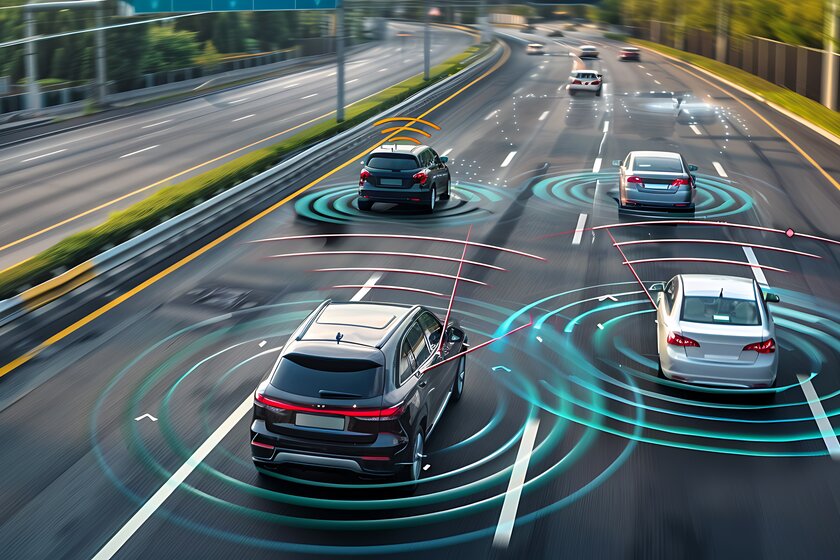
Drive-by-Wire & Autonomous Driving – The Key Technology for Level 5
1. Why Mechanical Steering Systems Are Incompatible with Autonomous Driving
Fully autonomous Level 5 vehicles must operate without any human intervention. In this highest autonomy stage, there is no steering wheel or pedals—the vehicle manages all driving functions independently.
However, traditional mechanical steering systems are not suitable for this transformation. A physical connection between the steering wheel and wheels creates several challenges:
- Mechanical components take up space, which contradicts the interior design concepts of autonomous vehicles.
- Higher maintenance costs due to moving parts and wear.
- Limited flexibility for software-based vehicle control, since mechanical systems cannot be seamlessly integrated into digital steering logic.
The solution: Drive-by-Wire.
This fully electronic steering system replaces mechanical linkages with digital signals, sensors, and actuators—making it the foundation for fully autonomous vehicles.
2. Why Drive-by-Wire is Essential for Level 5 Vehicles
For a vehicle to drive autonomously and safely, the steering system must:
- Execute commands in real time with the highest precision
- Adapt dynamically to changing road conditions
- Be fail-operational and redundant
- Seamlessly integrate into autonomous control software
Mechanical systems cannot meet these requirements because they lack digital integration. Drive-by-Wire enables precise, software-controlled maneuvers that are essential for autonomous mobility.
3. Technological Requirements for an Autonomous Drive-by-Wire System
To qualify for Level 5 autonomy, a Drive-by-Wire system must include:
- Millisecond-Precision Control & Sensor Fusion
An autonomous vehicle makes thousands of decisions per second based on camera, radar, Lidar, and other sensors. Steering systems must react in real time to ensure safe operation.
- 2oo3 Sensor Architecture for Maximum Safety
Three independent sensors validate each steering movement. If one sensor provides incorrect data, the system ignores it and relies on the two matching measurements.
- Fail-Operational ECU with A/B-Side Processing
The Electronic Control Unit (ECU) operates with dual independent computing channels (A/B) to ensure that even in case of an error, the steering remains reliable.
- Redundant Steering Actuators
If one steering actuator fails, a backup actuator immediately takes over to prevent any loss of control.
4. Critical Scenarios & Challenges in Autonomous Driving
Scenario 1: Sudden Lane Change on Wet Roads
An autonomous vehicle changes lanes at high speed onto a wet surface with reduced traction.
Without Drive-by-Wire:
A mechanical system requires more time to adjust—potentially causing instability.
With Drive-by-Wire:
The system immediately detects the traction change and adjusts steering inputs within milliseconds.
Scenario 2: Emergency Evasive Maneuver
An autonomous taxi must quickly swerve to avoid a suddenly appearing obstacle.
Without Drive-by-Wire:
Mechanical steering may be too slow or imprecise, as it lacks software-optimized reaction capabilities.
With Drive-by-Wire:
The system calculates the optimal steering path and executes the maneuver instantly.
5. Regulatory Requirements & Safety Standards for Autonomous Drive-by-Wire
United States (FMVSS & NHTSA)
- FMVSS 126 – Electronic Stability Control (ESC) regulations
- SAE J3016 – Classification of driving automation levels (including Level 5)
- NHTSA Safety Guidelines – Best practices for Drive-by-Wire in autonomous vehicles
European Union (UNECE & ISO)
- ISO 26262 (ASIL-D) – Functional safety for vehicle systems
- UNECE R79 – Regulations for Steer-by-Wire systems
- UNECE R156 – Safety requirements for software updates
Arnold NextG fully complies with these standards, providing a Drive-by-Wire solution optimized for Level 5 autonomy.
6. Conclusion & Preview of Blog 4 (Regulations & Drive-by-Wire Certification Requirements)
Without Drive-by-Wire, true autonomous driving is impossible. The precision, safety, and digital integration of this technology make it the key component for Level 5 vehicles.
But what legal hurdles must Drive-by-Wire systems overcome before hitting the road? Here we will explain soon the global regulations & certification requirements that Drive-by-Wire systems must meet.

